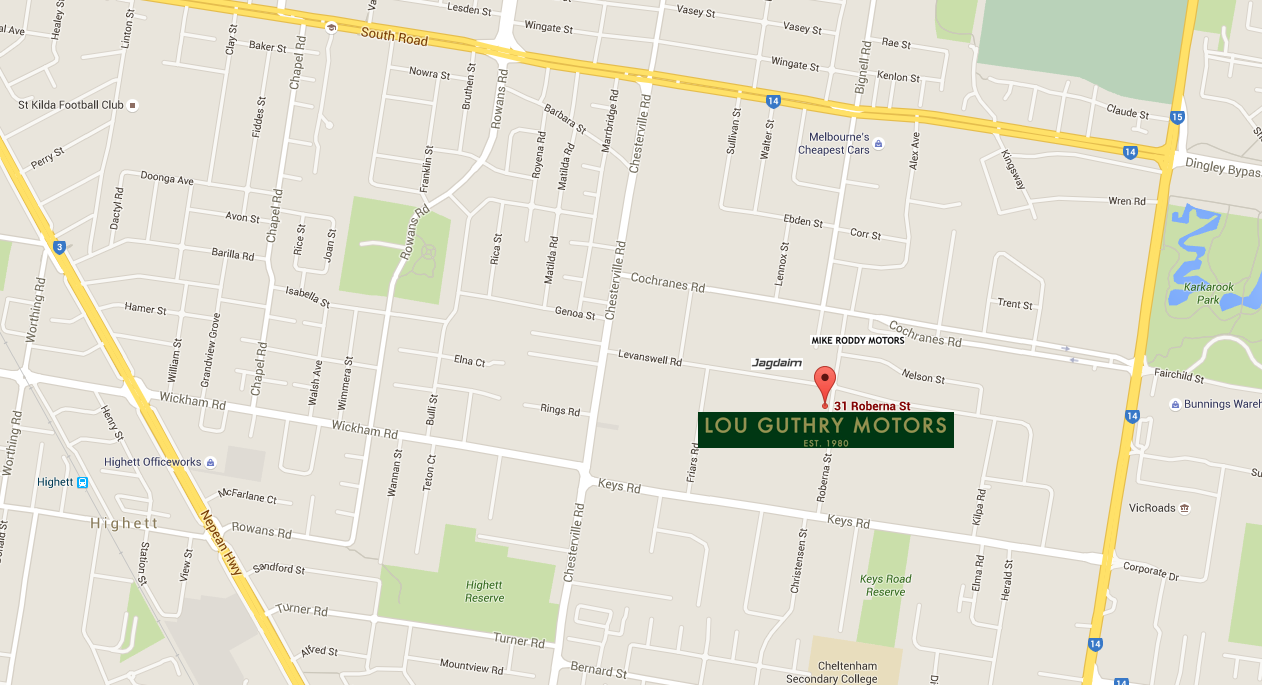We Have Moved!
We have moved!
We have already outgrown our current location!
Our new address is: 31a Roberna Street Moorabbin, VIC 3189 Australia
Phone: +61 418 536 129
Mobile: 0418 536 129
Email: laguthry@bigpond.net.au
View on Google Maps Click Here
Click on the map below for closer detail on our new location at: 31a Roberna Street Moorabbin, VIC 3189 Australia
Like us on Facebook: Lou Guthry Motors
Follow us on Twitter: @LouGuthryMotors
Follow us on Pinterest: Lou Guthry Motors
Jaguar Returns to Racing
Jaguar has announced its return to global motorsport. In the autumn of 2016, Jaguar will enter the third season of the exciting FIA Formula E Championship as a manufacturer with its own team. FIA Formula E is the world's first global single-seater championship for electric powered cars.
FIA Formula E offers a unique opportunity for Jaguar Land Rover to further the development of future EV powertrain including motor and battery technology.
Nick Rogers, Group Engineering Director for Jaguar Land Rover, said: "I am proud to announce Jaguar's return to racing with an entry into the innovative FIA Formula E championship. Electric vehicles will absolutely play a role in Jaguar Land Rover's future product portfolio and Formula E will give us a unique opportunity to further our development of electrification technologies. The Championship will enable us to engineer and test our advanced technologies under extreme performance conditions.
It is my belief that over the next five years we will see more changes in the automotive world than in the last three decades. The future is about being more connected and more sustainable; electrification and lightweight technologies are becoming more important than ever as urbanisation continues to increase. Formula E has recognised and reacted to these trends and the championship's exciting and pioneering approach is the perfect fit for our brand."

Jaguar Land Rover employs over 8,000 engineers and is the UK's largest investor in research and development across any business sector. Jaguar's Formula E team will be able to draw upon this industry leading resource with Jaguar Land Rover engineers working closely with the race operations team.
Those engineers will not only be able to apply their knowledge within the race team environment but crucially use the experience to extract data and push the boundaries of electric technology in a performance environment.
Williams Advanced Engineering will be Technical Partner to the Jaguar Formula E Team and provide extensive motorsport knowledge, combined with high performance EV Systems experience and success. Jaguar Land Rover has a long term relationship with Williams, who partnered with Jaguar on the development of the Jaguar C-X75 plug-in hybrid concept car. The team entry has been granted by Formula E and approved by the Fédération Internationale de l'Automobile (FIA).
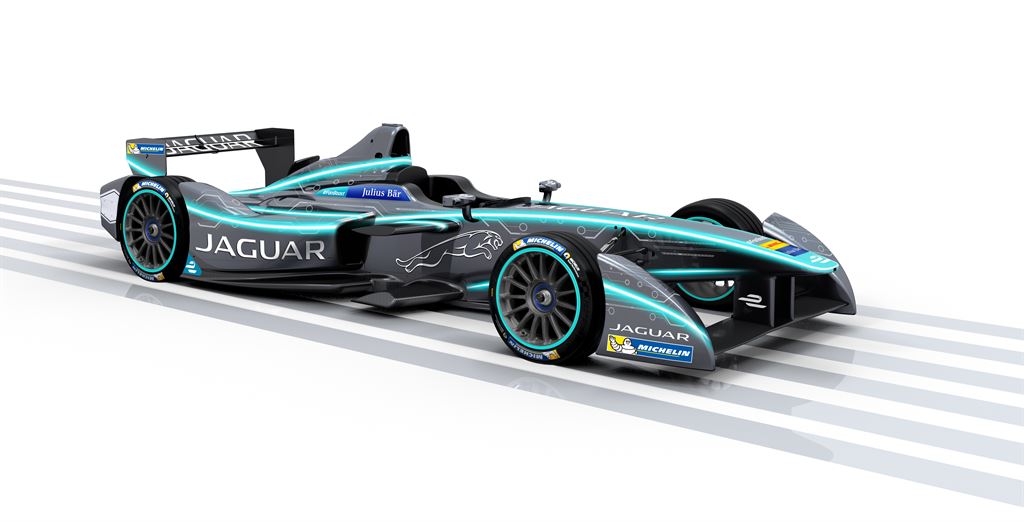
Alejandro Agag, Chief Executive Officer for Formula E, said: "We are delighted to welcome Jaguar into Formula E. Jaguar is a brand with a rich sporting heritage and the fact that it is returning to global motorsport with Formula E is a huge endorsement of the championship and its ability to influence the development of electric cars. Jaguar brings with it a passionate fan base that will drive the popularity of the championship across the world and once again shows that Formula E is the future of motorsport."
Jean Todt, President of the FIA said: "The FIA is pleased to welcome Jaguar as a new manufacturer to enter the FIA Formula E Championship. We built this series to offer an alternative competition for manufacturers to step into the sport and develop road-relevant electric technologies. The choice of Jaguar to come back to motor racing with Formula E is a proof of success. As it forges a path forward for the future of the electric car, Formula E managed to attract one of the most prestigious and historical brand across the automotive industry. I wish them success ahead of their arrival in 2016/2017".
James Barclay, Jaguar Team Director, said: "We looked in detail at alternative ways of returning to motorsport. This was such an important decision for Jaguar and we wanted to get it right. With our future EV plans, Formula E was the obvious choice and we believe that the benefits are enormous. The FIA and the promoter have exciting plans for the future of the championship and we are proud to be one of the first vehicle manufacturers to commit to the series with our own team. We have a lot of work to do ahead of the first race but it is a challenge we relish. We hope that we can welcome a new generation of fans to Jaguar through this exciting programme."
More details on Jaguar's return to racing including team presentation, drivers and partners will be released in the run up to season three.
Felipe Massa Drives Bond Villain's Jaguar C-X75 Supercar
Jaguar's C-X75 supercar featured in the new Bond adventure, SPECTRE, made its Americas debut in Mexico City with Williams Martini Racing driver Felipe Massa at the wheel. This activity celebrates the Americas movie premiere, taking place in Mexico City on 2nd November, and the Formula One™ Gran Premio de Mexico.
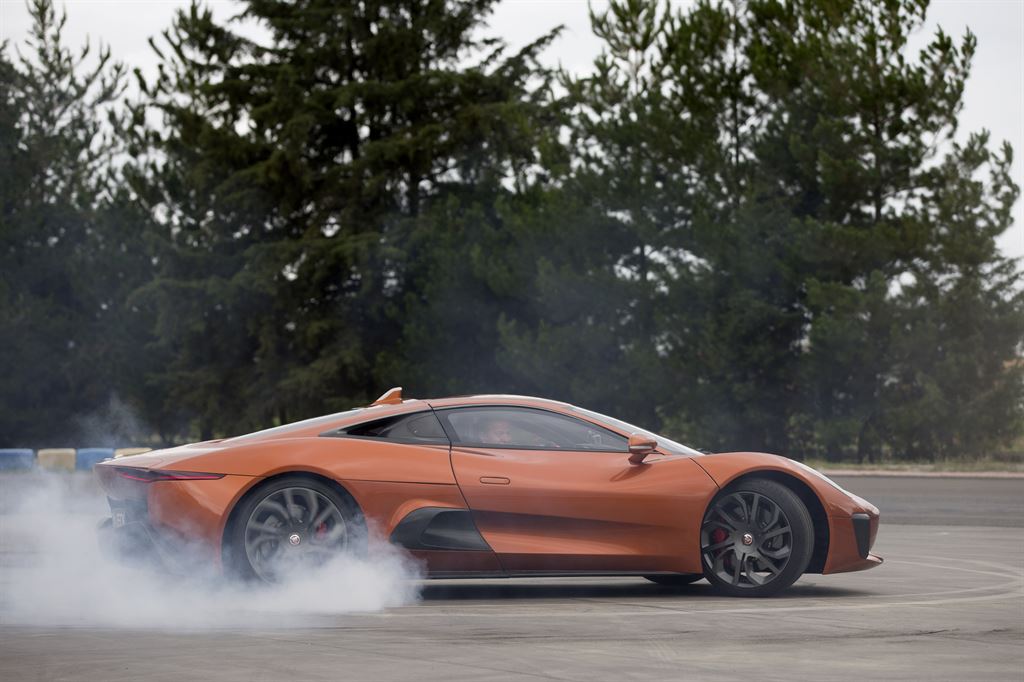
Williams Martini Racing driver Felipe Massa, said: "It was a thrill to take the wheel of a real stunt car used in a Bond movie. Jaguar partnered with Williams Advanced Engineering on the production of these stunning supercars, so it was great to experience some of what my colleagues have developed outside of F1. It was so much fun, and very exciting to be driving the Jaguar on a SPECTRE filming location here in Mexico City."
SPECTRE, the 24th James Bond film, from Albert R. Broccoli's EON Productions, Metro-Goldwyn Mayer Studios and Sony Pictures Entertainment, sees the Jaguar C-X75 driven by Hinx in one of the movie's most iconic high speed car chases.
Driven by actor Dave Bautista, who plays Hinx in the movie, the C-X75 supercar, named the most advanced Jaguar ever created, was provided by Jaguar Land Rover Special Vehicle Operations (SVO) in collaboration with development partner Williams Advanced Engineering.
The All-New Jaguar F-PACE – the World’s Ultimate Practical Sportscar is Revealed
The all-new Jaguar F-PACE has been revealed to the world with a spectacular gravity-defying performance on the eve of the Frankfurt Motor Show. The F-PACE showcased its dynamic performance credentials by completing the world's largest 360 degree loop and - in celebration of Jaguar's 80th anniversary- lit up the city's skyline with its dramatic C-X17 inspired silhouette.
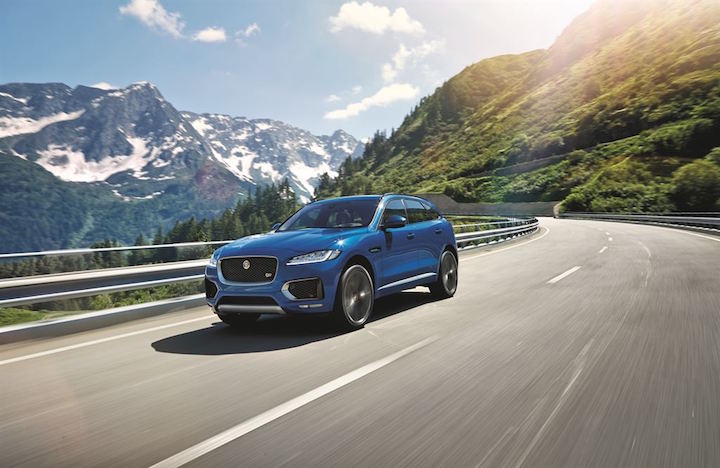
The Jaguar F-PACE is a performance crossover designed and engineered to offer the agility, responsiveness and refinement that all Jaguars are renowned for, together with unrivalled dynamics and everyday usability.
Developed using Jaguar's Lightweight Aluminium Architecture, the all-new F-PACE delivers on the promise of the breakthrough C-X17 concept vehicle and combines purity of line, surface and proportion with F-TYPE-inspired features such as the powerful rear haunches, fender vents and distinctive tail light graphics.
The bold front grille and the muscular bonnet hint at the performance potential of engines like the 380PS supercharged V6. Elements such as slender full-LED headlights, forged 22-inch wheels and short front overhang carry the design vision of the C-X17 concept through to production.
The all-new F-PACE seats five adult occupants in absolute comfort with generous head and knee room and the luggage compartment volume is an astonishing 650-litres.
Infotainment and connectivity technology is industry leading. The premium InControl Touch Pro system is based around a 10.2-inch touchscreen, with a powerful quad-core processor and solid-state drive, and runs on ultra-fast Ethernet. The result is a user interface which is instinctive and extremely quick with sharp and incredibly responsive graphics. Up to eight devices can be connected to the vehicle's super-fast wifi hotspot at one time.
The navigation system can save you time by learning your commute, offers true door-to-door guidance and can even advise others of your arrival time. Navigation can also be shown full-screen - in 3D - in the 12.3-inch HD virtual instrument cluster.
The Lightweight Aluminium Architecture gave the Jaguar design and engineering teams - now recognised globally as leaders in aluminium technology and design - the ideal starting point. It was created from the outset as a modular structure, so the wheels can be positioned exactly where they are needed to deliver the proportions, dynamics, and practicality essential for a performance crossover.
The wheelbase and track are not shared with any other Jaguar. At 4,731mm long and with a 2,874mm wheelbase, the all-new F-PACE offers the sleek profile and short front overhang characteristic of Jaguar design together with an exceptionally spacious interior.
"By remaining absolutely true to our design principles the all-new F-PACE is immediately recognisable as a Jaguar. It offers all of the interior space you would expect - and more - but because of our disciplined approach to surfaces, proportions, and purity of line, we have designed what I consider to be the most balanced, most attractive vehicle in its class. The Jaguar F-PACE is the ultimate practical sports car"

Ian Callum, Director of Design, Jaguar
The light, stiff body structure comprises 80 per cent aluminium, and is the only aluminium-intensive monocoque in the segment. Additional weight savings come from the composite tailgate and magnesium for parts such as the cross-car beam.
The result is that the rear-wheel drive 180PS diesel manual transmission model weighs as little as 1,665kg and achieves CO2 emissions of just 129g/km. With the 380PS supercharged V6 petrol engine from the F-TYPE under its sculpted aluminium bonnet, the all-new F-PACE can accelerate from 0-60mph in just 5.1 seconds before reaching an electronically-limited top speed of 155mph.
The body's high torsional stiffness enables the F-TYPE-derived double wishbone front suspension and sophisticated Integral Link rear suspension to perform even better. Together with Torque Vectoring as standard and an Electric Power Assisted Steering system tuned to give the best possible feel and response, the all-new F-PACE sets the benchmark for ride and handling.
Even the entry-level model benefits from monotube dampers as standard, but for even better ride and handling the electronically-controlled Adaptive Dynamics system measures body and wheel movement 100 and 500 times a second respectively, ensuring optimum damping forces in all conditions.
For the most enthusiastic drivers there's Configurable Dynamics: first used in the F-TYPE, this feature allows individual settings for the throttle, automatic transmission, steering, and, where fitted, the Adaptive Dynamics system.
"The all-new F-PACE is a Jaguar that customers around the world demanded that we make. The targets we set are among the most challenging we've ever had to deliver but I'm proud to say that the all-new F-PACE meets or exceeds every one of them.
"This is a performance crossover with outstanding dynamics yet also delivers a smooth, quiet ride. The F-TYPE-inspired design combines dramatic looks with a spacious interior and an exceptionally large luggage compartment. Together with our all-new infotainment system, our most advanced all-wheel drive system and an outstanding range of active safety technologies, the all-new F-PACE makes every journey a better, more rewarding experience."
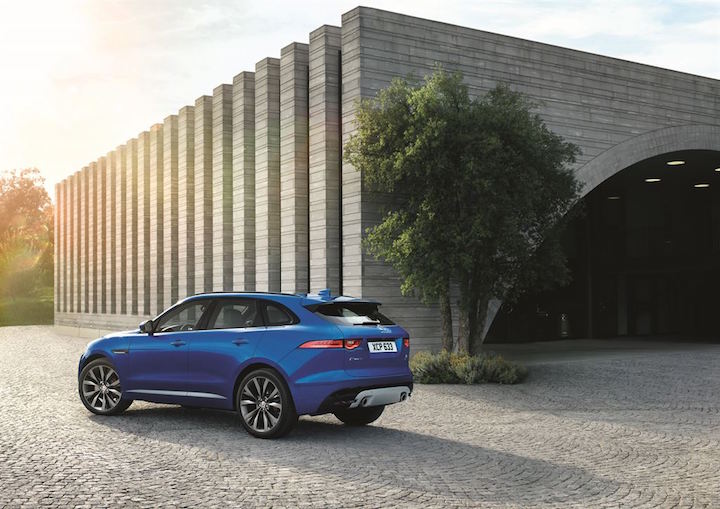
Kevin Stride, Vehicle Line Director, Jaguar F-PACE
The all-new F-PACE's torque on-demand all-wheel drive (AWD) system is Jaguar's most sophisticated yet, and has the highest torque capacity. It features the advanced, in-house control system first developed for F-TYPE AWD: Intelligent Driveline Dynamics (IDD). IDD preserves rear-wheel drive agility and handling character but can seamlessly transfer torque to the front wheels to exploit the performance benefits of extra traction, on all surfaces and in all weathers.
Adaptive Surface Response (ASR), developed from sister brand Land Rover's patented, award-winning Terrain Response technology, makes the AWD system even more effective in challenging conditions. Integrated into Jaguar Drive Control, ASR identifies the type of surface and optimises the mapping of the powertrain and Dynamic Stability Control system. First launched in the all-new XF, ASR has been enhanced by a third mode designed for deep snow and gravel. Additional technologies available to ensure for all surface performance include the existing Jaguar systems; All Surface Progress Control and Low Friction Launch.
The all-new F-PACE has been engineered to satisfy the most stringent safety standards worldwide and provides exceptional levels of occupant and pedestrian protection. The standard of active safety is just as high, thanks to a suite of advanced driver assistance systems. The state-of-the-art stereo camera at the heart of the Autonomous Emergency Braking system now features a pedestrian detection function - a Jaguar-first. The stereo camera also enables Lane Departure Warning, Lane Keep Assist, Traffic Sign Recognition, an Intelligent Speed Limiter, and Driver Condition Monitor systems.
Key information such as vehicle speed and speed limits can be projected directly into the driver's line of sight by the laser head-up display.Compared to conventional systems, laser technology is smaller and lighter and the images remain clear even in bright sunlight.
The all-new F-PACE also brings the world debut of Jaguar's Activity Key. A waterproof, shockproof wristband with an integrated transponder, this segment-first, wearable technology supports active lifestyles because it allows the keyfob to be securely locked inside the vehicle - invaluable if you're going surfing, for example, or kayaking. Locking the all-new F-PACE using the Activity Key will disable any keyfobs left inside.
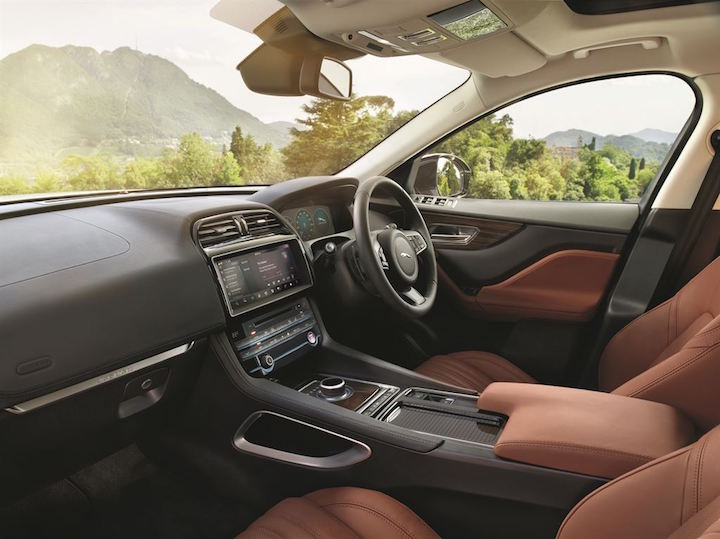
Range summary
The all-new F-PACE range will consist of: F-PACE Pure, F-PACE Prestige, F-PACE Portfolio, F-PACE R-Sport, F-PACE S, F-PACE First Edition.
The powertrain range will consist of: 180PS 2.0-litre diesel manual RWD/ AWD and automatic AWD; 240PS 2.0-litre petrol automatic RWD; 300PS 3.0-litre diesel automatic AWD; 340PS and 380PS 3.0-litre petrol automatic AWD.
The all-new F-PACE is manufactured at Jaguar Land Rover's Solihull Plant in the UK alongside the Jaguar XE sports saloon.
Jaguar XE Review | Auto Express
By Auto Express Test Team Auto Express
The XE had a tough job on its hands to topple the compact exec big guns like the BMW 3 Series, Audi A4 and Mercedes C-Class, but Jaguar has done just that as the new Jaguar XE has been crowned the Auto Express Compact Executive Car of the Year 2015.
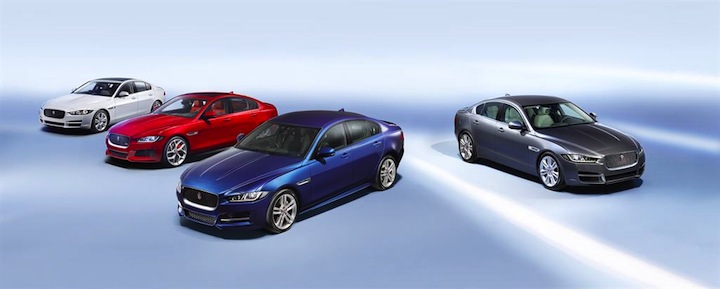
The success of the XE is down to a mix of stunning looks with cues taken from the F-Type sports car, frugal yet powerful diesel engines and the feeling of high-end luxury thanks to its sumptuous leather-clad interior. These all add up to a package that’s appealing to both private and company car buyers.
In terms of engines in the Jaguar XE, there are plenty of options for diesel and petrol fans. The diesel engines are the predicted bestsellers, with a 161bhp 2.0d Ingenium unit kicking things off. If you want a bit more power, there’s also a 178bhp 2.0-litre diesel unit available.
Petrol-wise, the XE is available with a 2.0-litre turbocharged engine producing either 198bhp or 237bhp, while a 3.0-litre supercharged V6 with 335bhp sits at the top of the range and turns the XE into a proper performance saloon.
That’s not to say the XE doesn’t deliver on the road, though. It’s not quite as sharp as a 3 Series, but it’s not far off the German benchmark and offers a GT-like approach with a relaxed, comfortable drive that we think works well in this car.
Jaguar XE models start out with the entry-level SE, and move up through to Prestige, R-Sport and Portfolio specs. The 237bhp 2.0-litre turbo petrol engine is only available in higher-spec R-Sport and Portfolio trims, and the range-topping V6 is only available in bespoke XE S trim level.
In-car tech in the XE marks a step up for Jaguar. The new InControl Touch infotainment system features full Apple and Android smartphone connectivity. Plus, all XEs come with sat-nav, cruise control, 17-inch alloys and DAB radio as standard.
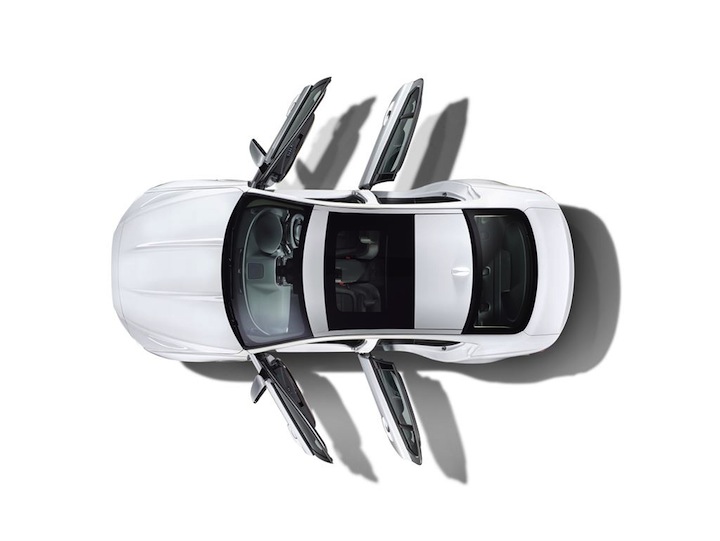
Styling 4.2
The Jaguar XE may look conservative, but when you see it on the road it has real presence. Jaguar is developing a look that will extend through the range, from the XJ through XF and on to the F-Pace SUV, with wide, slim headlights, an upright grille and a low, sleek bonnet.
The J-Blade LEDS on the XE accentuate the width at the front, as do the F-Type-style rear lights. The low roof-line at the back gives the car a coupe-like stance adding to the drama, with big wheels pushed out to the far corners. The inside is simple yet stylish, with a wraparound fascia similar to that on the XJ, which makes the car feel welcoming inside.
Range topping S variants add beefier front and rear bumpers as well as larger alloy wheels. It's by far the most handsome XE in the lineup with the more aggressive styling amplifying its coupe like proportions.
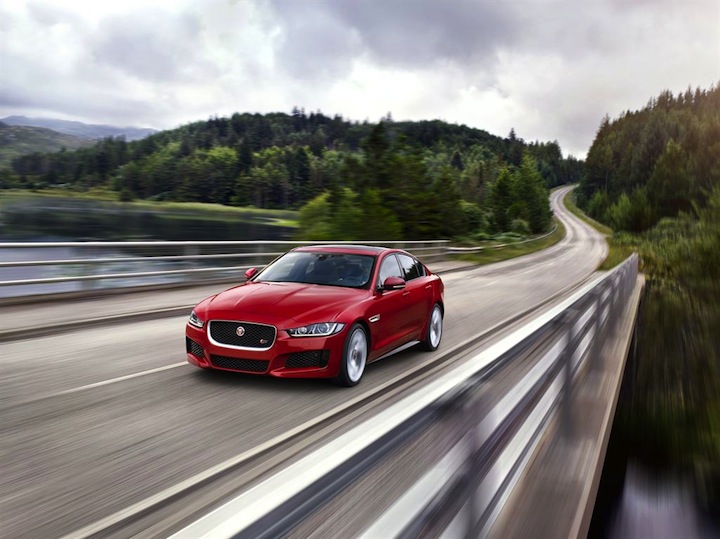
Driving 4.7
Of the two diesels, the lower powered unit has impressive emissions of 99g/km, making it the company car user’s pick. The more powerful 178bhp engine, meanwhile, is smooth and punchy, yet still efficient.
Throttle response is good and refinement is excellent thanks to the new Ingenium diesel engines. It begins to make itself known above 4,000rpm but because most of the power is available before then you rarely have to extend the diesel engine beyond that.
Even our R-Sport model with its sportier settings and bigger wheels rode well – it’s firm, but forgiving and feels exactly how you’d want a small sporting Jaguar saloon to feel. The electric power steering is quick to react and offers plenty of feel when away from the slightly numb straight ahead position. The eight-speed auto gearbox shifts swiftly too.
The supercharged V6 3.0 XE S uses the same engine as the Jaguar F-Type and that makes for a swift saloon, but it never feels massively rapid. Torque Vectoring by the braking system makes for a sharp turn-in and reduces understeer, while there’s plenty of grip on the exit.
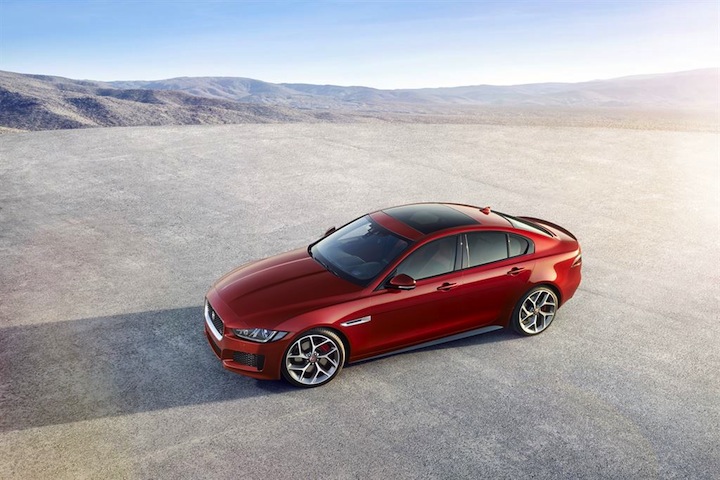
Reliability 4.4
Jaguar has a fine reputation for reliability these days, coming an excellent second (and top of all premium makes) in the manufacturer rankings of our annual Driver Power survey. It even beat Lexus (fourth), while Mercedes was ninth, BMW 10th and Audi 12th.
In the unlikely event that anything should go wrong, Jaguar dealers out punch all their rivals, with the exception of Lexus. Jaguar dealers finished way ahead of Mercedes, BMW and Audi dealers in Driver Power 2014. Safety-wise, Jaguar is predicting a five-star rating for the XE, which gets all the expected safety kit as standard, with plenty of advanced safety options, too.
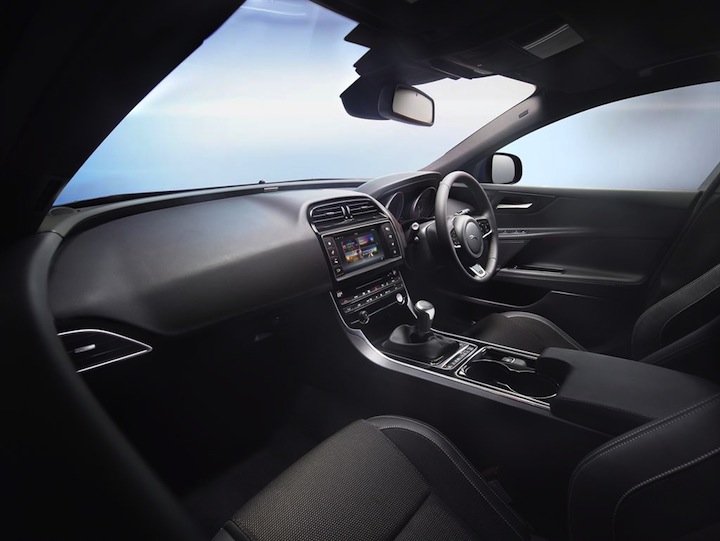
Practicality 3.7
Sitting a six-foot tall passenger behind a six-foot tall driver won’t be a problem in the Jaguar XE – there’ll be an inch or so of legroom to spare, while the roof lining has been designed to offer decent headroom, too.
The doors open nice and wide at the front and back, making getting in and out easy. However, a wide transmission tunnel means the centre console in the front is quite wide, while anyone sitting in the middle seat in the back will have their knees apart and feet fighting for space with those of passengers sitting in the outer chairs.
The boot is marginally smaller than the 3 Series’, concentrating more on depth than width – it appears slightly narrow, but still offers okay space. You get 450 litres of capacity as standard and 455 litres in models without a spare wheel.

Running Costs 4.4
The Jaguar XE diesels match the BMW 3 Series for performance, but currently beat the BMW on CO2 and mpg – until a facelifted 3 Series arrives later in 2015, that is.
The lower-powered diesel gets below the 100g/km threshold that’s so important to company car drivers and should return mpg figures in the 60s, making for long periods between fill-ups.
On the official combined cycle, the entry-level diesel acheives 75mpg with the manual gearbox or 72mpg with the auto. At the other end of the scale, it's 34.9mpg and 194g/km for the supercharged XE S model.
The XE doesn’t have the price advantage over rivals that some Jaguars have had, but all models tend to be slightly better equipped than rivals like-for-like. In such a hugely competitive sector, we’d expect maintenance costs for the Jaguar to be on par with rivals, too.
By Auto Express Test Team Auto Express
Mille Miglia Reflections: The 2015 #JaguarMille Team on Film
Following a hugely successful Mille Miglia in 2015, Jaguar Heritage has released a film of this year's rally, giving viewers an in-depth look at an event once described as 'The most beautiful race in the world'.
In the year that Jaguar celebrates its 80th anniversary, the official Jaguar Heritage team headed to the start in Brescia with three C-types, three D-types, two XK120s and an XK140 driven by famous faces from the world of motorsport, TV and music. Following the Jaguar Heritage cavalcade were a group of media guests driving various examples of new Jaguar XE and latest generation of F-TYPE sports cars.
Supported by an expert crew of Jaguar Heritage technicians, the nine Jaguar entries ran smoothly throughout the gruelling four-day event. Driven by the likes of supermodel David Gandy, model and TV presenter Jodie Kidd, and musician Elliot Gleave - better known as Example - the Jaguar Heritage team finished strongly in the Mille Miglia's regularity trial rankings, too.
Jaguar Director of Design, Ian Callum, who was driving an Ecurie Ecosse D-type said: "It's a huge privilege to be part of that car's history - because it's made even more history now, being part of the Mille Miglia. This year's drive was pure enjoyment for me, pure exhilaration. This event is amazing - it gives you a unique feeling for what the car is about. It underlines exactly what the Jaguar brand is all about."
TV chef and renowned car collector James Martin - who drove a Jaguar Heritage D-type with adventurer Charley Boorman - said of the event: "You feel elated at the end. It's just the most amazing feeling. I've been through the turmoil and the heartache of not finishing the Mille Miglia so to be able to cross that line...I'm a tough Yorkshire farmer, but I had tears in my eyes!"
All New Jaguar XF Makes Debut
The all-new Jaguar XF today made its global motor show debut in New York. Formed around Jaguar's aluminium-intensive architecture, the all-new XF will bring an unrivalled blend of design, luxury, technology, dynamic capability and efficiency to the business car segment.
Ian Callum,Director of Design, Jaguar, said: "I believe the all-new XF is the best looking car in its class. Elegant, handsome and with proportions that imbue a great sense of integrity - the all-new XF is true to the great tradition of sporting Jaguar saloons while being completely of its time."
The all-new XF's dynamic, coupé-like design combines the outstanding proportions, elegant surfaces and perfect lines which define all Jaguar cars, with a longer wheelbase, more interior space and exceptionally low aerodynamic drag.
The all-new XF range will consist of: XF Pure/ SE, XF Prestige, XF R-Sport, XF Portfolio, XF S.
The powertrain range will consist of: 163PS and 180PS 2.0-litre diesel manual and automatic; RWD, 240PS 2.0-litre petrol automatic; RWD, 300PS 3.0-litre diesel automatic; RWD and AWD, 340PS and 380PS 3.0-litre petrol automatic.
Manufactured at Jaguar Land Rover's Castle Bromwich Plant, the all-new XF joins the Jaguar saloon car range between the XE and XJ model lines.

The all-new Jaguar XF brings an unrivalled blend of design, luxury, technology and efficiency to lead the business car segment, underpinned by class-leading driving dynamics and refinement.
The dynamic, coupé-like design is formed around Jaguar's aluminium-intensive architecture and combines the outstanding proportions, elegant surfaces and perfect lines which define all Jaguar cars, with a longer wheelbase, more interior space and exceptionally low aerodynamic drag.
The cabin is a seamless blend of contemporary luxury materials and finishes, traditional Jaguar craftsmanship and state-of-the art technology, with features such as a reconfigurable 12.3-inch TFT instrument cluster, laser head-up display and the InControl Touch Pro premium infotainment system - the all-new XF is the most connected Jaguar ever.
The 2007 XF was a radical step forward for Jaguar - and for the business car segment. Combining a sleek, coupé-like exterior and a luxurious interior, it set the class benchmark for aesthetics and driving dynamics.
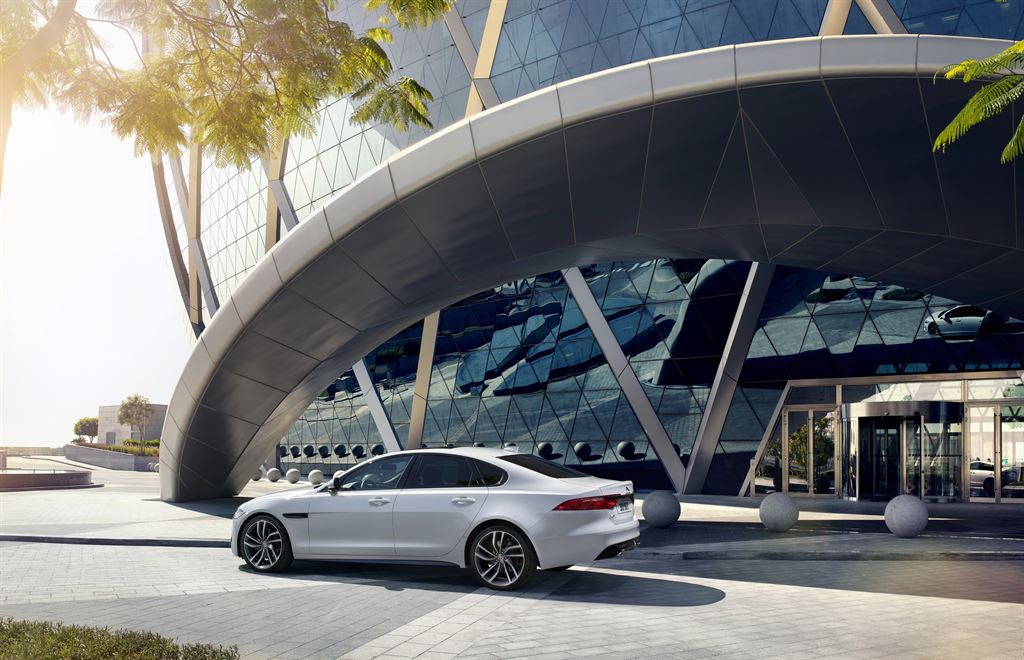
Features such as the rotary shift controller, rotating air vents and phosphor blue ambient lighting set the cabin apart from the competition and made the XF a highly desirable, aspirational vehicle. It was like nothing Jaguar had ever made before, and like nothing the competition could offer. The XF went on to become the most-awarded Jaguar ever.
The all-new XF retains its predecessor's core attributes, but uses Jaguar's aluminium-intensive architecture to enable weight savings of up to 190kg - making the 163PS diesel model 80kg lighter than the nearest competitor - plus an increase in torsional stiffness of up to 28 per cent. The architecture also delivers dramatic improvements in packaging and the proportions so essential to Jaguar design.
The all-new XF is 4,954mm long: at 2,960 the wheelbase is 51mm longer than before, the front overhang 66mm shorter. Though 7mm shorter and 3mm lower than the original XF, rear seat space is class-leading thanks to 15mm more legroom, 24mm more kneeroom and up to 27mm more headroom than before. Aerodynamics are also superior: the drag coefficient drops from 0.29 to just 0.26.
The light, stiff body is also fundamental to the all-new XF's superb vehicle dynamics. Double wishbone front suspension and Integral Link rear suspension - combined with near-50:50 weight distribution - deliver the ideal balance between ride and handling.
"From an engineering perspective, our targets with the all-new XF were bound by one holistic goal - it had to do everything better, and it does.
"It offers even better dynamics, even greater refinement for the comfort of its occupants, it delivers an all-new infotainment system, and it utilises every last mm of packaging to maximise interior space, while exploiting all the weight-saving optimisation offered by our new aluminium-intensive architecture. As a driver you will notice these benefits from the moment you sit behind the wheel."
Ian Hoban, Vehicle Line Director, Jaguar XF
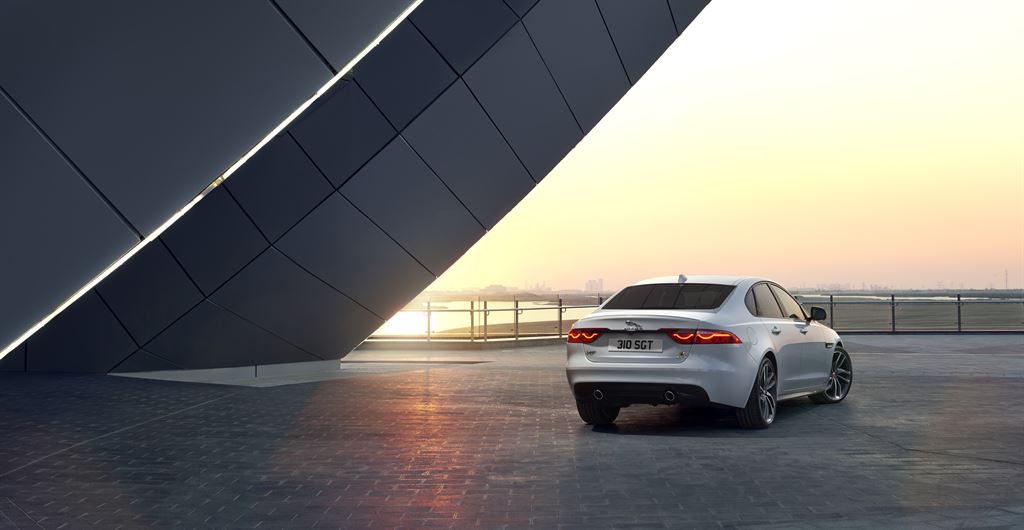
Adopting Electric Power Assisted Steering (EPAS) maintains Jaguar's leadership in steering feel but also reduces fuel consumption by up to two per cent and three per cent for diesel and petrol models respectively. EPAS also enables functions such as camber compensation and advanced driver assistance systems including lane-keep assist, driver condition monitoring and bay- and parallel park-assist.
Advanced passive damper technology delivers exceptional ride quality as standard through an extra valve which reduces damping forces at low speeds. For even better control the Adaptive Dynamics system monitors body movement 100 times a second and wheel movement 500 times a second to determine the optimum damper settings for the driving conditions.
Jaguar Configurable Dynamics technology, optional on all V6 models, provides the ultimate in control and enables the driver to individually tailor settings of the dampers, steering, engine and eight-speed automatic transmission.
All-wheel drive (AWD) was engineered into the vehicle from day one. The torque on-demand system is new, and the transfer case features a lighter, quieter, more efficient chain drive.
Capability is also enhanced by the advanced control system first used in F-TYPE AWD: Intelligent Driveline Dynamics (IDD). This delivers rear-drive handling with the performance and traction benefits of AWD.
A first for XF AWD is the addition of the Adaptive Surface Response (AdSR) mode to Jaguar Drive Control. Leveraging Jaguar Land Rover's unrivalled expertise, AdSR identifies the type of surface, such as snow or gravel, and adapts the mapping of the engine, transmission, steering and Dynamic Stability Control to make the vehicle even more composed in low-grip conditions.
Ability is unrivalled in rear-wheel drive form too. All-Surface Progress Control, developed for low-speed driving in adverse conditions, automatically manages the brakes and the throttle to deliver the best possible traction, enabling the car to pull away smoothly and without drama: the driver only has to steer. ASPC operates between 3.6km/h and 30km/h, and the desired speed is set by the driver using the cruise control switches.
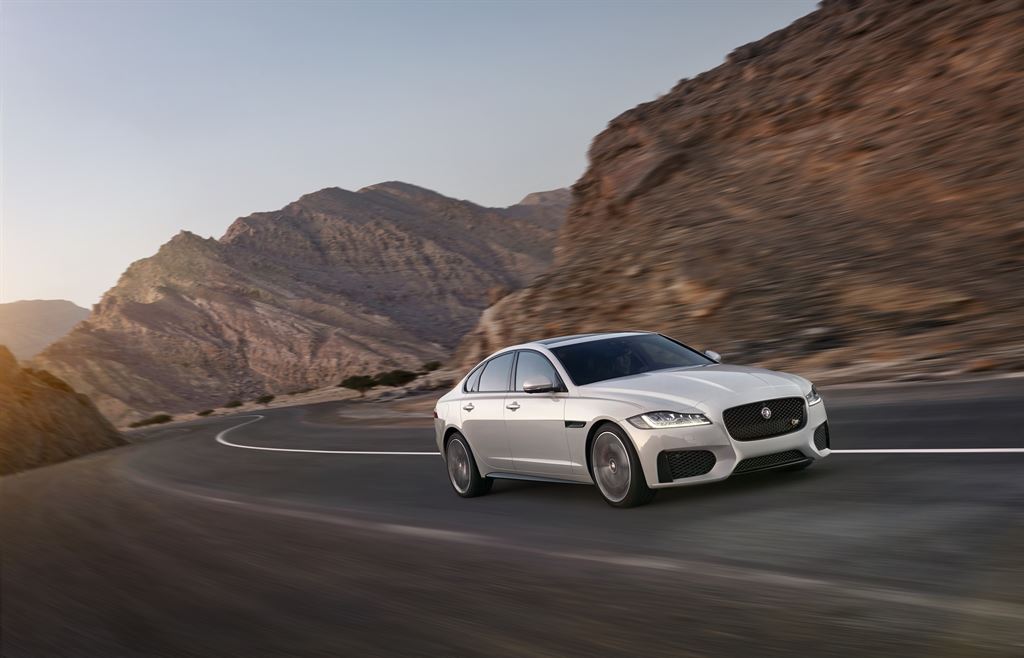
Infotainment and connectivity is the most advanced Jaguar has ever offered. The all-new InControl Touch Pro system builds on the intuitive user interface of InControl Touch, and supports all the same features - including InControl Apps, InControl Remote and Wi-Fi hotspot - but offers a 10.2-inch touchscreen and Dual View technology which simultaneously allows the driver to see information such as navigation, while the front seat passenger watches TV or a DVD.
To enrich the experience there's also natural voice control, supporting commands such as 'more like this' for track selection, and 10GB of the 60GB solid-state drive is dedicated to media storage, enabling Gracenote album art to be displayed. Audio systems include the exceptional 17-speaker, 825W Meridian digital surround sound system.
To handle the enormous amounts of data, InControl Touch Pro features a high-performance quad-core processor and runs on state-of-the-art, ultra-fast Ethernet, a network technology which offers exceptional data transfer rates of up to 1Gbit/second. Combined, they deliver incredible graphics, fast response times and help to future-proof the system for significant upgrades in functionality over time.
To minimise driver distraction the all-new XF offers a colour laser head-up display. Compared to competitor systems, this technology is smaller, lighter, and generates high contrast images which are easier to read in strong sunlight.
Stereo camera technology enables autonomous emergency braking, lane departure warning and lane-keep assist systems. Adaptive Cruise Control with Queue Assist takes the stress out of motorway driving in stop-go traffic by tracking the vehicle in front, at a safe distance.
The traffic sign recognition system brings Jaguar's first application of an intelligent speed limiter. Once set, the system monitors speed limit signs, compares them with navigation data and, when a change in speed limit is posted, can regulate vehicle speed by either smoothly accelerating the car up to a higher limit or slowing it down to a lower limit.
The all-new XF is also the first Jaguar to offer adaptive full-LED headlights. Featuring two banks of LEDs and reflectors - one for dipped beam, the other for main beam - they generate light with a colour temperature closer to that of daylight than is achievable with Xenon lights, delivering better illumination. At the same time, energy consumption is reduced. So efficient are they that, unlike first-generation designs, cooling fans are not needed.
If the high-beam assist function is specified, the stereo camera will detect other vehicles in the distance, and the headlights will be dipped automatically as necessary to avoid dazzling other drivers.
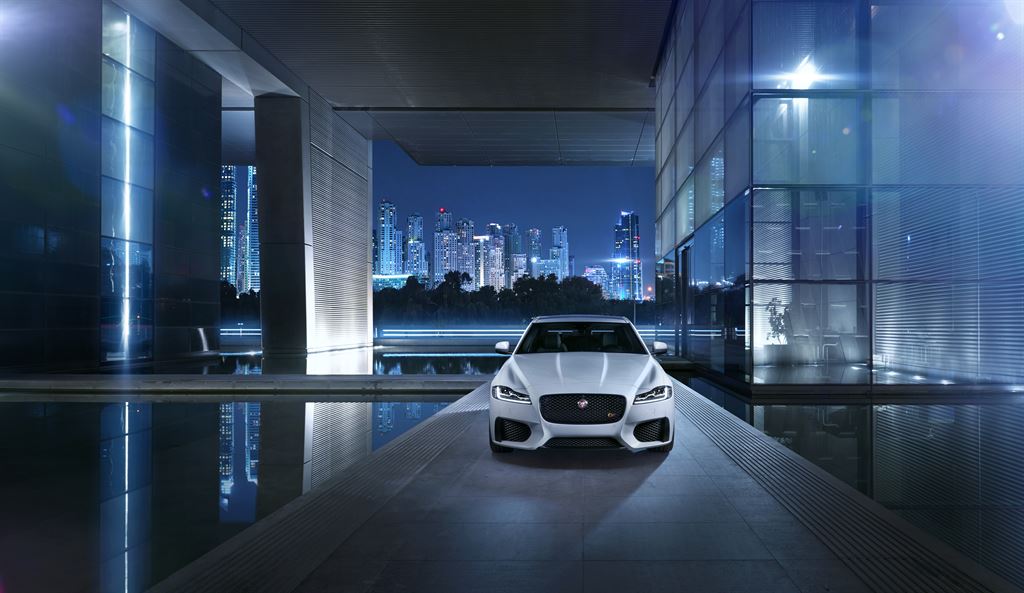
Range summary
The all-new XF range will consist of: XF Pure/ SE, XF Prestige, XF R-Sport, XF Portfolio, XF S.
The powertrain range will consist of: 163PS and 180PS 2.0-litre diesel manual and automatic; RWD, 240PS 2.0-litre petrol automatic; RWD, 300PS 3.0-litre diesel automatic; RWD and AWD, 340PS and 380PS 3.0-litre petrol automatic.
Manufactured at Jaguar Land Rover's Castle Bromwich Plant, the all-new XF joins the Jaguar saloon car range between the XE and XJ model lines.
"The XF nameplate sits at the very heart of Jaguar; the original XF was revolutionary for the brand, and now the all-new aluminium-intensive XF represents another innovative step-change within the business segment.
"Lighter and more efficient, with enhanced space, an all-new premium infotainment system, a greater breadth of powertrains, unrivalled dynamics and refinement and, of course, world-leading design, the all-new XF offers customers a compelling package."
All New Jaguar F-PACE
Jaguar has today confirmed it will introduce an all-new model to the Jaguar line-up, to go on-sale in 2016, named the Jaguar F-PACE.
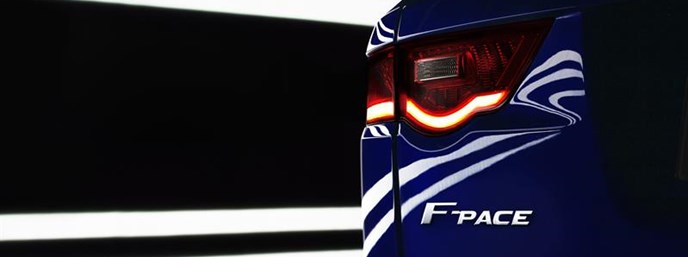
Ian Callum, Director of Design, Jaguar, commented: "We received such an overwhelmingly positive response to the C-X17 concept car last year that we just had to make it a reality.
"The Jaguar F-PACE, inspired by the F-TYPE, represents a perfectly judged balance of performance, style and practicality. It offers a unique combination of Jaguar sports car inspired exterior design, fused beautifully with a thoroughly practical and spacious luxury interior. The F-PACE is our family sports car."
The Jaguar F-PACE couples class-leading interior space and exceptional on-road dynamics with five-seat usability to produce a true performance crossover. It will encapsulate everything that Jaguar stands for: beautiful design, precise handling, a supple ride, luxurious interior finishes and cutting-edge technology.
Speaking in Detroit, Andy Goss, Jaguar Land Rover Global Sales Director said: "In 2015 we will celebrate Jaguar's 80th year. We have started it by announcing our first performance crossover which we consider to be the ultimate practical sports car - a car that builds on the marque's founding ideals of Grace, Pace and Space to become one of the most innovative Jaguars we've ever developed. The F-PACE has now begun its engineering and development testing programme ahead of the new model going on sale in 2016."
The F-PACE will be manufactured in Solihull, UK.
Watch the video to see how the name of this F-TYPE-inspired performance crossover was revealed.
Jaguar reveals the F-PACE performance crossover as C-X17 concept enters production
Alex Buncombe Monaco Historic Jaguar C Type Qualifying
Onboard with Alex Buncombe driving the Ex Fangio C Type at Monaco Historic 2014.
The New Jaguar XE - The Sports Saloon Redefined
The Jaguar XE redefines the concept of the sports saloon and will be the driver's car in its class. Its lightweight construction, streamlined styling, luxurious interior and outstanding ride and handling are testament to company founder Sir William Lyons' vision: 'The car is the closest thing we will ever create to something that is alive'
The rear-drive XE is the only vehicle in its class to use an aluminium-intensive monocoque. This extremely robust yet light structure, together with double wishbone front suspension and an Integral Link rear axle, is fundamental to the XE's innovative benchmark vehicle dynamics.
Jaguar's world-leading expertise in aluminium structure engineering enables exceptional fuel consumption and emissions figures: with the new Ingenium diesel engines, the XE can achieve 75mpg and 99g/km CO2 - the most efficient Jaguar ever.
Powered by the supercharged 3.0-litre V6 petrol engine from the acclaimed Jaguar F-TYPE, the XE S is capable of 0-60mph in just 4.9 seconds.
"The XE's driving behaviour fully matches the promise of its seductive looks, and the emotional appeal is supported by state of-the-art approaches to efficiency, from aerodynamics to the advanced Ingenium engine family."
Kevin Stride, Vehicle Line Director, Jaguar XE

The aluminium-intensive Jaguar XE is the first model developed from Jaguar Land Rover's new modular vehicle architecture. The long 2,835mm wheelbase and low seating position enable perfect proportions and a streamlined profile.
The cabin offers outstanding levels of comfort and spaciousness. Exquisite materials and finishes combined with Jaguar craftsmanship make this a class-beating interior that's unlike anything else in the segment. Jaguar's new InControl Touch infotainment system takes centre stage: its innovative 8-inch touchscreen brings fast, intuitive access to all features and functions - and iOS and Android smartphone apps.
The XE has some of the most advanced driver assistance systems available. All Surface Progress Control (ASPC), developed through decades of Jaguar Land Rover experience in off-road traction systems, can electronically gain traction in seconds and is ideal for use on low-grip surfaces, such as snow-covered roads.
Laser projection technology enables the XE's head-up display (HUD) to generate sharp, high-contrast colour graphics (such as vehicle speed and navigation) from a module smaller and almost a third lighter than existing systems, retaining clarity even in direct sunlight.
A stereo camera is mounted behind the front windscreen to give the XE a 3D view of the road ahead: this highly accurate data is used for functions including autonomous emergency braking and a lane departure warning system.
The XE is the stiffest, most aerodynamic Jaguar saloon car ever built. It is also the first Jaguar to be equipped with electric power steering, tuned to provide exceptional responsiveness and feel but with lower energy consumption than hydraulic systems. The XE also boasts the lowest cost of ownership and most environmentally sustainable credentials of all Jaguar models.
Manufacturing of the aluminium-intensive Jaguar XE occurs at Jaguar Land Rover's Solihull plant in an all-new facility. Part of a £1.5bn investment, this flexible, purpose-built site will create 1,700 UK jobs.
The XE now completes the Jaguar saloon car range, sitting below the XF and XJ model lines.
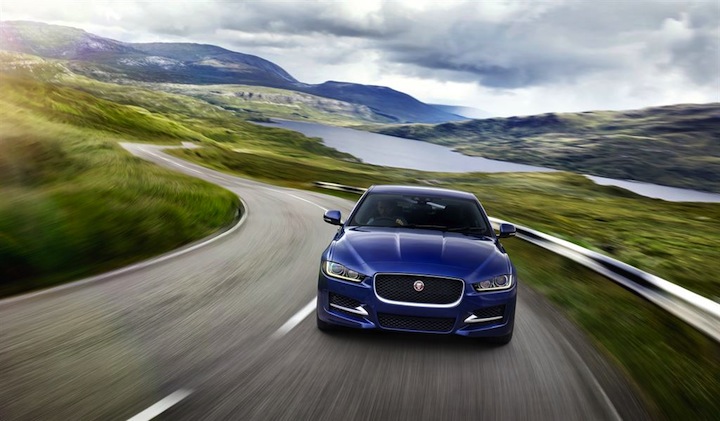
THE XE RANGE
From luxurious to high-performance, the XE range offers a model perfectly suited to every taste
Sports saloons tailored to suit every driver
Each XE is designed to offer an unrivalled combination of steering response, ride comfort, refinement and performance. These attributes are matched to the sleek, perfectly-proportioned exterior styling and the premium materials and meticulous attention to detail defining the interior.
Pure:
The entry-level to the XE range, the Pure* model features high-quality cloth seats and a gloss black treatment for the door trim finishers and the signature 'Riva Hoop' sweeping around the instrument panel.
R-Sport:
Seats are trimmed with Taurus leather with unique technical mesh fabric inserts. The 'Riva Hoop' and door finishers are in etched aluminium, and the tread plates and sports steering wheel feature R-Sport branding. The exterior is enhanced
by a subtle rear spoiler and a noble chrome treatment for the side power vents. sports suspension delivers even better handling.
S:
The most performance-orientated XE model features a race-inspired interior. The Taurus leather seats have suede cloth panels and the tread plates and leather sports steering wheel carry the S logo. Dark hex aluminium graces the door finishers and the 'Riva Hoop', while the centre console is gloss black. The front bumper's enlarged air intakes hint at the performance potential of the supercharged V6. Side sill extensions, rear spoiler, gloss black rear valance, red brake calipers and optional forged, 20-inch 'Propeller' alloy wheels complete the package.
Prestige:
Taurus leather upholstery with contrasting stitching delivers a modern, progressive luxury interior, complete with phosphor blue ambient lighting. Inserts on the air-conditioned seat option are perforated and the 'Riva Hoop' and door finishers are finished in brushed aluminium.
Portfolio:
The most luxurious XE model, Portfolio features a wide range of colour options for the premium Windsor leather with herringbone perforations. The instrument panel features split upper and lower coverings in two colours, complete with colour-keyed twin-needle stitching for a truly bespoke feel. The aluminium trim has an embossed surface finish.
*SE in the UK

DESIGN
The most advanced sports saloon that Jaguar has produced, the new XE is instantly recognisable as a Jaguar, its aluminium skin formed around the fundamental principles of perfect proportions and aerodynamic efficiency. The new XE looks and feels like no other car in its class
Purity and purpose: Form and function without compromise
Always at the forefront of innovation, Jaguar created the blueprint for the first ever sports saloon with the iconic Mk II, a car which distilled sports car performance and dynamics into a stylish four-door body. The new XE builds on this unique heritage, combining Jaguar's unrivalled expertise in lightweight construction with exquisite lines, sharp radii and perfectly executed surfaces.
The only car in its class to use an aluminium-intensive monocoque, the XE was developed in parallel with Jaguar's lightweight, modular vehicle architecture. Created from a clean sheet, this architecture - which will form the backbone of several future Jaguar models - unlocks entirely new design possibilities for the brand.
"Great proportions and a dynamic, edgy feel are at the core of Jaguar design. We wanted to create a strong sense of movement, and have given the XE a dynamic and purposeful look that is without compromise. Sleek, low, coupe-like exterior proportions combine with an efficient package that is instantly recognisable as
a true Jaguar."
Ian Callum, Jaguar Director of Design
The strongly-sculpted bonnet is a testament to Jaguar's expertise in working with aluminium, creating a taut, muscular appearance. The very steeply raked windscreen and the rising waistline accentuate the streamlined, coupe-like profile, adding to the sense of movement.
The signature 'J-Blade' running lights are another instantly recognisable Jaguar design. In the rear lights, a horizontal line intersecting a roundel is an iconic styling feature inherited from the iconic Jaguar E-type.
Smooth progress: Sleek styling, low aerodynamic drag
Jaguar has a rich history of designing stunning, yet aerodynamically efficient cars. The new XE continues this tradition of uncompromised form and function: its profile has the lowest drag coefficient of any Jaguar yet - Cd 0.26. This was achieved through a combination of over 1,200 computational fluid dynamics (CFD) simulations and over eight million hours of processor time.
The body's low-drag shape is enhanced by features that amplify each improvement made. Innovations include front bumper ducts which channel laminar airflow over the surface of the front wheels to reduce drag. This is combined with lightweight under-floor panels running back to the rear silencer, creating an almost perfectly smooth surface, also significantly reducing drag.
Inside story: Spacious, luxurious
Expectations raised by the XE's beautiful exterior styling are exceeded once inside. The spacious cabin cocoons front seat passengers with a deep centre console, creating a cockpit-like feel. The 8-inch touchscreen for the new InControl Touch infotainment system takes centre stage in the sweeping curves of the instrument panel. On models equipped with automatic transmissions, Jaguar's unique rotary drive selector rises up from the centre console - the XE feels alive.
The contour-hugging front seats are mounted low, creating a sports-car like driving position with heating and cooling options and up to14-way power adjustment. The rear seats may also be heated and can offer a 40:20:40 split-fold - a first for Jaguar - and a through-loading feature.
The XE proves that sleek, streamlined styling and interior space need not be mutually exclusive. All occupants enjoy generous amounts of head and legroom, and the deeply scalloped seatbacks liberate even more space for passengers seated in the rear of the XE.
Technical fabrics, fine-grain leathers and contrasting twin-needle stitching give the cabin a bespoke quality. Gloss black, textured aluminium, contemporary wood veneers, and carbon-fibre trim enhance a luxurious, handcrafted feel.
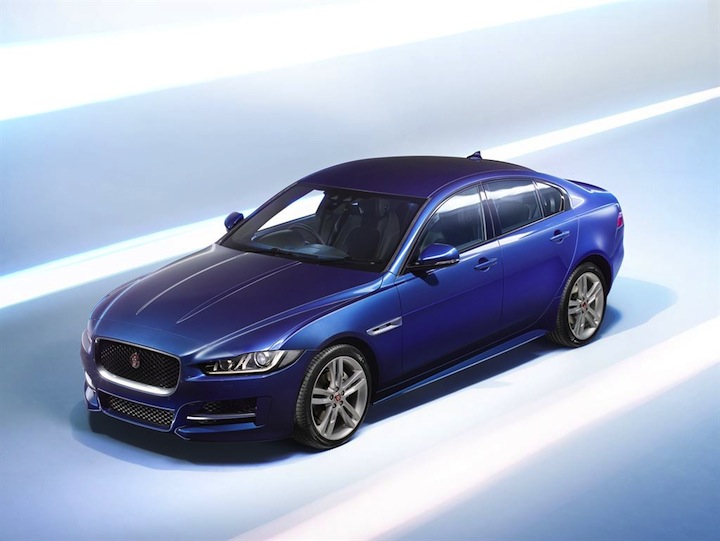
BODY STRUCTURE
Jaguar is more experienced in the use of aluminium construction than any other vehicle manufacturer, allowing the development of the revolutionary body structure of the new XE. It is the only car in the class built around an aluminium-intensive monocoque
Light, stiff, safe
Following development of the aluminium XJ in 2003, the XK, the current XJ and the F-Type, Jaguar's experience is embodied in the new XE's aluminium-intensive monocoque. The XE is the most rigid saloon that Jaguar has ever built and no other vehicle in the mid-size segment contains more aluminium.
"The Jaguar XE body uses over 75% aluminium content, which far exceeds any other car in its class. This gives us a body structure with unrivalled low weight: it's light but also immensely strong with extremely high levels of torsional stiffness and safety without compromising on vehicle design or refinement"
Dr Mark White, Jaguar Chief Technical Specialist, Lightweight Vehicle Technologies
The XE is the first model designed using Jaguar's all-new modular vehicle architecture. This advanced structure, which will underpin a range of different models in a number of different segments, is engineered to utilise the most intelligent mix of materials, including aluminium, high-strength steel and magnesium, providing exceptional manufacturing flexibility.
For the XE, satisfying the demanding targets for ride, handling, fuel economy and safety dictated an aluminium-intensive monocoque. When Jaguar started work on the original aluminium XJ, the luxury saloon's body comprised around 70 per cent conventional grades and 30 per cent high-strength alloys respectively. In the new XE, these proportions have been reversed.
High-strength aluminium alloys, including AC300 and AC600 grades, are also used in areas such as the A-pillars, front and rear crash structures, and the cant rail. The B-pillars are high-strength aluminium reinforced with ultra-high strength steel, with a layer of high-density foam between.
All of this makes the passenger compartment exceptionally stiff, preventing intrusions in the event of a collision. The new XE has been engineered to meet the most stringent legislative and consumer crash test requirements worldwide, including US and Euro NCAP.
Pedestrian protection reaches new levels too: the energy absorbing properties of the aluminium bonnet are enhanced by a deployable hinge system, which creates additional clearance between the underside and stiff structures such as the powertrain, suspension towers and the bulkhead.
Recycled aluminium alloy: A world-first
Sustainability is another big part of the story at Jaguar Land Rover. The new XE is the first car in the world to use a high-strength aluminium alloy - RC5754 - made predominantly from recycled material. The product of several years of research, this grade contains only a small quantity of primary material, essential to achieving the desired mechanical properties.
Steels, including advanced high-strength and dual-phase steels, are used for parts such as the rear underbody, door panels and bootlid. These materials satisfy the particular strength, stiffness and geometrical requirements of these parts and they also contribute to the XE's ideal weight distribution. Cast magnesium also makes an appearance: this ultra-light material is used to make the front-end carrier as well as the cross-car beam.
Aerospace-inspired joining technologies
In 2003, replacing spot welds with a combination of self-piercing rivets and structural adhesives - a technique proven in aircraft production - represented another step-change in body engineering at Jaguar. These techniques enable highly optimised joint design with an outstanding combination of strength, stiffness and durability. Another advantage - and one extremely difficult to realise with welding processes - is compatibility with dissimilar materials.
To prevent any risk of galvanic corrosion between steel and aluminium panels the XE's monocoque benefits from five layers of protection between the two materials. The first is a protective coating of zinc on the steel parts. The joints are filled with structural adhesive and then the body is e-coated. Seam sealer is applied, and then, finally, paint.
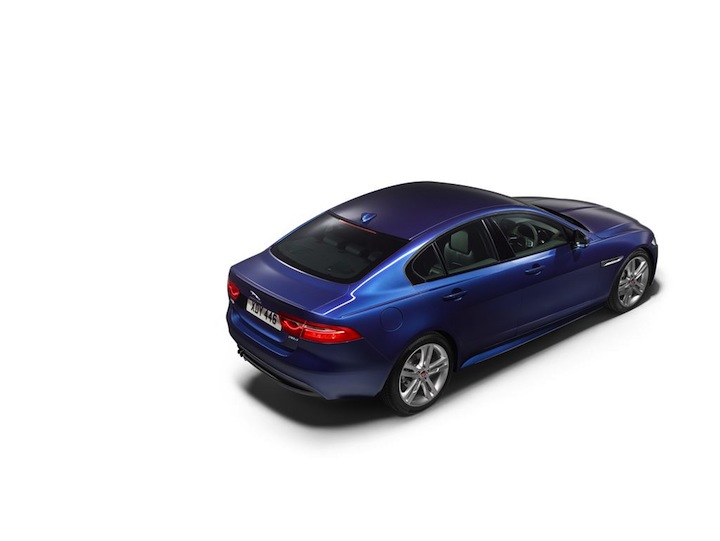
CHASSIS
Jaguar saloons have always been renowned for their matchless combination of sublime ride comfort and outstanding driving dynamics. The new XE will take this to the next level thanks to double wishbone front suspension, Integral Link rear suspension and Jaguar's first application of electric power steering. Development target: be the driver's car in the segment
Agile, responsive, supple
Designing the XE entirely from scratch using a brand new architecture presented the programme team the rare opportunity to develop a car free of the compromises imposed by legacy platforms and carryover components. As a result the XE has the most sophisticated chassis of any vehicle in its class and will set the benchmark for ride and handling.
The XE's light, stiff body structure and longitudinal, rear-drive powertrains provided the perfect starting point for development. Where most competitors use the simple MacPherson strut front suspension, Jaguar's vehicle dynamics team insisted on the superior double wishbone configuration.
"Jaguars have always been renowned for a balance of precise handling and a high-quality ride. The XE is the culmination of everything the company has learned over the years, providing a combination of supple ride and crisp handling
that is unmatched in this segment."
Mike Cross, Chief Engineer of Vehicle Integrity, Jaguar
Camber stiffness was an important consideration. This attribute - the resistance to lateral load when the car is cornering - is crucial to steering feel. To keep unsprung mass to a minimum, the forged aluminium knuckles are made from cast blanks using a patented production process. Further weight savings come from the tubular anti-roll bars and springs made from stiffer, narrower-gauge steel.
Front suspension geometry was optimised from the outset to suit all-wheel drive and rear-wheel-drive configurations. The suspension mounting points enable efficient packaging of the spring and damper assembly - essential to achieving the low bonnet height fundamental to the XE's sleek styling and to pedestrian impact protection.
The dampers have been meticulously tuned, giving the sublime ride quality Jaguar cars are famous for and the taut body control needed for agile handling.
Integral Link: The most sophisticated rear suspension in the segment
Jaguar evaluated conventional multilink suspensions that are the class standard, but these could not deliver the dynamic attributes demanded of the new XE.
The solution was Integral Link: a system usually found only in larger, more expensive vehicles and which delivers benchmark performance. Only Integral Link delivers the combination of lateral and longitudinal stiffness needed for the XE's precise handling and smooth, quiet, supple ride.
To keep weight to a minimum, extensive use has been made of aluminium: toe links and upper control arms are forged; knuckles and lower control arms are hollow cast, saving even more weight.
Electric power steering redefined
Steering response, weight and feel are core elements of Jaguar's brand DNA, and the ones which probably contribute most to the '50 metre feel' - the all-important first impression that the vehicle conveys about the way it drives.
Hydraulics have provided power assistance because they deliver the most natural, intuitive system performance. Electric power steering (EPAS) offers greater tuning potential and greater energy efficiency, but Jaguar's engineers have not considered the technology sufficiently mature - until recently.
As a result, the new XE is the first Jaguar to use EPAS and delivers the immediate response and connected feel expected of a Jaguar sports saloon. All system hardware has been optimised to reduce backlash and friction - the enemy of natural steering feel - while the control software was honed during an exhaustive tuning phase. The control algorithms can even account for changes in the ambient temperature, ensuring a consistent steering feel no matter what the conditions.
As well as functions such as speed-dependent assistance and damping, which varies subtly with the rate with which steering lock is applied, the steering system also compensates for changes in road camber, keeping the car firmly on track.
EPAS also cuts the XE's CO2 emissions by 3 per cent and 2 per cent from petrol and diesel models respectively.
High performance brakes
The dynamic driving character of the new XE is matched by brake system specification. Lightweight sliding calipers and large discs are used front and rear, with diameters from 316mm to 350mm and 300mm to 325mm respectively.
The ventilated front discs benefit from enhanced cooling thanks to suspension-mounted ducts, which channel air to the centre of the rotors through apertures in the back plate.
The latest-generation electronic brake system controller is lighter, smaller and more powerful than previous modules and enables myriad functions which improve safety, stability and dynamics.
Torque Vectoring by braking
One of the most impressive functions on the new Jaguar XE is Torque Vectoring by braking - state-of-the-art technology that has been proven on the F-TYPE Coupé and is now standard on the new XE.
This high-tech innovation mitigates the onset of understeer by lightly braking individual inner wheels as required to help keep the car on the optimum line through corners.
Intervention is subtle and barely noticed by the driver, who benefits from more neutral handling, reduced steering effort and, ultimately, a more rewarding driving experience.

POWERTRAIN
The XE is powered by a range of four- and six-cylinder petrol and diesel engines offering a blend of performance, refinement and efficiency from 99g/km CO2 to 250km/h. All engines benefit from direct injection, variable valve timing and boosting to deliver clean, quiet combustion and exceptional throttle response. Intelligent stop-start systems and smart regenerative charging save even more fuel. Power is sent to the rear wheels through smooth-shifting 6-speed manual and 8-speed automatic transmissions
Smooth, refined, efficient
Jaguar is launching the new XE with an equally new engine family - Ingenium. This advanced modular design will provide petrol and diesel derivatives and was started from a clean-sheet to deliver performance, efficiency and refinement without compromise.
The first Ingenium engines in the Jaguar XE are 2.0-litre four-cylinder diesels with a choice of two power and torque outputs: 163PS/380Nm and 180PS/430Nm. The 163PS version makes the XE the most fuel-efficient Jaguar ever, achieving 75mpg and 99g/km CO2 on the European combined cycle.
Proven over 2 million miles of testing, Ingenium forms the cornerstone of Jaguar's future low-CO2 powertrain strategy. It will also meet the most stringent exhaust emissions legislation worldwide.
"The new generation of Ingenium diesel engines are wholly designed and manufactured in-house at our new engine plant in Wolverhampton. No opportunity has been missed in ensuring their design is right on the cutting edge of technical advancement to achieve the highest levels of efficiency, performance and refinement."
Ron Lee, Group Chief Powertrain Engineer, Jaguar Cars
All Ingenium engines, developed from scratch by Jaguar engineers, are based around a deep-skirt aluminium cylinder block featuring thin-wall, press-fit cast iron liners: these offer the best balance of weight, surface finish, and robustness.
The engine's split-cooling system, mapped thermostat, and fully variable mechanical water pump enable standing water in the block while coolant circulates through the crossflow channels in the cylinder head. So the engine warms up more quickly, reducing friction and therefore fuel consumption.
Parasitic losses have been cut in other ways too: the electronically-controlled oil pump matches its flow rate according to engine speed, load and temperature, and switchable piston cooling jets operate only when needed.
Variable valve timing has been a feature on all Jaguar petrol engines for many years, and now the technology is making its way into the diesel too: the Ingenium units benefit from a cam phaser on the exhaust side. Variable exhaust valve timing enables more rapid catalyst heating, thereby minimising harmful emissions during the critical warm-up phase.
Fuel is fed to the combustion chambers by an 1,800bar solenoid common rail system. Key attributes are low noise, high efficiency and excellent mixture formation.
Ingenium diesels are characterised by the rapid build-up of torque from very low engine speeds, enabled by highly efficient variable geometry turbochargers. Maximum torque is maintained over a wide rev range, ensuring instantaneous response and strong acceleration whenever the driver demands it.
Performance does not come at the expense of fuel economy: coupled to the six-speed manual transmission, the 163PS/380Nm version delivers the XE's benchmark 99g/km efficiency.
In more powerful 180PS/430Nm form, the figures are just as impressive for models equipped with either the manual or automatic transmissions.
Emissions minimised: Clean combustion and advanced aftertreatment
As well as a sophisticated exhaust gas recirculation system, Jaguar's powertrain engineers have integrated the most advanced exhaust gas aftertreatment technology into the XE: a highly efficient, selective catalytic reduction (SCR) system ensures that tailpipe NOx emissions are below the limits set by Euro 6 regulations.
Four-cylinder petrol engines blend performance with efficiency
The petrol engine range begins with the turbocharged, direct-injection, 2.0-litre four-cylinder unit, which made its debut in the Jaguar XF and XJ saloons. Further refined for the new XE, this refined, lightweight powerplant is available in two ratings: 200PS/280Nm and 240PS/340Nm.
Weighing only 138kg, these all-aluminium engines feature twin counter-rotating balancer shafts to cancel-out second order forces, offering the smoothness and power of a naturally aspirated six-cylinder but in a smaller, more efficient package.
An innovative feature is the sheet metal turbine housing integrated into the air-gap insulated exhaust manifold. As well as saving weight, the assembly's reduced thermal mass means that the catalyst reaches light-off temperature more quickly, reducing emissions. The low-inertia turbine wheel delivers outstanding transient response.
V6 supercharged: Power in reserve
For customers demanding superior performance and an exhilarating engine note from idle right up to the redline there's the XE S, which shares its supercharged 3.0-litre V6 with the lightweight F-TYPE sports car. This all-aluminium engine is a modular design with takes its core architecture, including the 90° cylinder bank angle, from Jaguar's acclaimed 5.0 V8.
A balancer shaft ensures that the V6 matches the larger unit for refinement, while the wide vee provides the packaging space for the twin-vortex Roots-type supercharger. Rated at 340PS/450Nm, this engine provides the XE S with truly exceptional acceleration, driveability and performance: 0-60mph takes just 4.9 seconds, and top speed is electronically-limited to 155mph.
Selecting the best: New six-speed manual transmission
The smooth-shifting manual transmission in the new Jaguar XE is characterised by its light, precise gear changes and a wide ratio spread offering a blend of excellent launch performance and quiet, refined cruising.
As well as rewarding keen drivers with its smooth shifts, the transmission also contributes to the XE's excellent fuel efficiency. Its lightweight aluminium alloy casing reduces weight, while details such as hollow shafts and pocketed gears make the transmission lighter still.
The pursuit of efficiency also meant adopting a semi-dry sump system instead of relying on the usual method of splash lubrication with its inherent parasitic losses. Instead, the oil is separated from the gears by a lightweight polymer baffle and sprayed onto the moving parts by a compact pump.
Optimised eight-speed automatic transmissions
The XE's aluminium-intensive construction has enabled weight-optimised versions of the benchmark eight-speed ZF 8HP transmission found in XJ and XF saloons to be offered with all petrol and diesel engines, saving around 10kg.
Always offering the right gear for any condition, the transmission ECU monitors driving styles and adapts shift patterns to suit. This intelligent control strategy makes the modes chosen in the Jaguar Drive Control system even more effective. In the high-performance XE S model, the transmission features steering wheel-mounted paddle shifts, giving the driver full manual control over gear changes for an even more involving experience.
Advanced driver assistance systems
Jaguar has developed a suite of technologies to make driving safer, more relaxing and more enjoyable. From systems that improve low-speed traction in adverse conditions to smart braking systems which use stereo cameras to scan the road ahead - the XE is the intelligent choice in the mid-size segment
Gaining traction: All Surface Progress Control
Making its world debut in the new XE is All Surface Progress Control (ASPC). This unique traction management system, akin to a low-speed cruise control, will give the XE unrivalled all-weather capability among rear-drive cars in the segment.
ASPC is ideal for low-grip surfaces such as snow-covered driveways and ungritted winter roads, and even wet grass. Developed with the input of decades of Jaguar Land Rover experience in off-road traction systems, ASPC can electronically gain traction with far less drama than the driver can achieve.
The system functions between 3.6km/h and 30km/h and is activated using the cruise control switches on the steering wheel. Having set the desired speed the driver concentrates on steering - the car takes care of the rest, ensuring smooth progress without skidding and without the driver touching the pedals. Available with automatic transmissions only, ASPC is compatible with all engines. Winter tyres make ASPC even more effective.
Laser Head-Up Display: Information right where it's needed
A first for Jaguar and for the industry, the XE's laser head-up display (HUD) projects high-contrast colour images directly in the driver's line of sight and is smaller and almost a third lighter than existing TFT systems.
The virtual images appear to 'float' two metres in front of the driver. Displaying information such as speed, turn-by-turn navigation instructions, traffic signs, and cruise control settings in this way means that the driver's eyes remain focused where they're needed most: the road ahead.
Greater contrast means greater resistance to image 'washout' in very bright sunlight. Another advantage of laser technology is that the images remain clearly visible should the driver be wearing polarised glasses.
Seeing things clearly: Stereo camera technology
The new XE is one of the first vehicles in the segment to feature a stereo camera. This state-of-the-art sensor provides a 3D view of the road ahead and is at the heart of the autonomous emergency braking (AEB) and traffic sign recognition systems.
Mounted in front of the rear-view mirror, the forward-facing stereo camera can detect vehicles up to 100 metres away. If the algorithms in the AEB control module determine that a collision is likely, the brake system is pre-charged and the driver receives a visual warning in the instrument cluster and, if fitted, the head-up display. If no action is taken, full braking force is triggered automatically: the AEB system enables collision avoidance or mitigation at speeds up to 80km/h.
The traffic sign recognition system relies on the stereo camera to keep the driver informed of speed limits - including temporary limits which apply in roadworks, for example. To ensure a high degree of system robustness, camera data is always cross-referenced with speed limit information from the navigation system. A driver-selectable function enables subtle notifications if speed limits are exceeded: a ring flashes around the speed limit image, but there is no audible warning.
In addition to road signs, the advanced stereo camera also 'sees' the road markings too, and this capability is used by the XE's lane departure warning system. If the system determines that the vehicle will unintentionally leave its lane, the driver receives haptic feedback through the steering wheel rim.
The stereo camera can also help the driver to see more clearly: intelligent control of the headlights enables greater use of high beam, making night driving safer. By networking the headlight modules to the camera's image processing algorithms, the high beam assist function will automatically dip the beams when oncoming traffic is detected.
Always looking ahead: Adaptive Cruise Control
The new XE's adaptive cruise control (ACC) makes motorway journeys even more comfortable. A long-range 77GHz scanning radar monitors the road ahead, enabling the car to maintain a pre-set distance from vehicles in front. The ACC system can also initiate emergency braking if it detects an impending collision.
Keeping watch: Blind Spot Monitoring with Closing Vehicle Sensing
The new XE can also be equipped with a system to monitor the area behind the car, making overtaking safer. Medium-range 24GHz radar sensors detect vehicles approaching fast from behind: a flashing icon in the mirrors alerts
the driver of the potential hazard. Once the vehicle enters the blind spot, the icon is shown as a solid.
Slotting into position: Parking made easy
The effort of trying to park in tight spots has become a thing of the past. The new XE can be specified with two semi-automated park-assist functions, which do the hard work for you. The ultrasonic sensors measure the space and, if suitable, will enable the car to steer itself during both parallel and bay parking manoeuvres - the driver only has to control the brakes and accelerator. An exit-assist function will guide the XE out again.
Backing out of parking spaces can be made even safer with the reverse traffic detection system. The sensors used in the blind spot monitoring system will detect approaching vehicles which may be unseen by the driver and can trigger an alert.
Infotainment and connectivity
From smartphone apps and Wi-Fi to premium audio systems developed with world-renowned experts Meridian - the new XE offers a suite of technologies designed to keep you informed and entertained, making every journey even more of an experience
Perfectly positioned in the sweep of the fascia, the eight-inch touchscreen is at the heart of the XE's all-new InControl Touch infotainment system.
The touchscreen features a clear, intuitive user interface designed to give quick, easy access to all features and functions. Voice control makes the system even simpler - InControl Touch responds to plain speech commands without the need to navigate down through menus, allowing drivers to keep their eyes on the road.
"In-car technologies in this ever-more connected and fast-paced world are an integral part of your driving experience. With the all-new XE we're introducing an entire suite of cutting-edge driver aids and entertainment systems. Designed and developed from scratch, they will ensure that every journey you take is simpler, more relaxing, safer, and effortlessly enjoyable."
Dr Mike Bell, Jaguar's Global Connected Car Director
A feature first developed for the flagship Jaguar XJ, dual-view technology is now available in the XE. This segment-first innovation enables the touchscreen to display vehicle information for the driver while, at the same time, front seat passengers can sit back and enjoy a movie.
Smartphones are changing the way people interact with the world around them - the new XE ensures that drivers stay connected. Jaguar InControl Apps allows users to seamlessly access smartphone apps through the XE's touchscreen, making it easy to do everything from make a conference call, find a parking space or book a hotel room. Some of the most popular apps include iHeartRadio, INRIX, Glympse, Stitcher, cityseeker and Parkopedia.
The XE also functions as a Wi-Fi hotspot, enabling multiple devices to connect to the internet - the vehicle antenna provides the best possible signal.
Jaguar InControl Remote allows users of iOS and Android smartphones to connect to the car from wherever they are using a specially-designed app. The technology enables a range of functions, from checking how much fuel is in the tank and unlocking or locking the doors, to seven-day timed pre-setting of the XE's climate control system.
InControl Secure enhances security by providing proactive vehicle monitoring. Should the XE be stolen, the tracking service can work with law enforcement agencies to locate and recover the car.
InControl Protect provides further reassurance: in the unlikely event of a malfunction, it provides optimised Jaguar Assistance, transmitting your location and vehicle diagnostic data to help minimise delays to your journey. Should the unthinkable happen and a collision occurs it will automatically make an SOS call and summon the emergency services.
Sound quality: Premium audio from Meridian
For drivers who just want to sit back and enjoy the music, the new XE brings Meridian audio technology to the segment for the first time. The latest product of the long-standing partnership between Jaguar and British audio experts Meridian, the 11-speaker system includes a powerful subwoofer and was developed specifically for the XE. Unique algorithms guarantee the best possible sound reproduction and tailor the experience to the interior's acoustics. With such an advanced music and infotainment system, the Jaguar XE will set a benchmark in its class for high quality driver and passenger entertainment that will be very difficult to beat.

